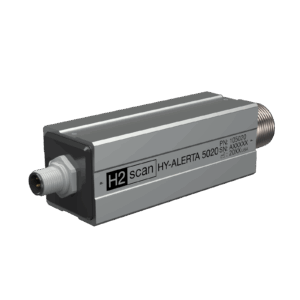
Crying Wolf: How Hydrogen Sensors Solve False Alarms from CO Detectors
Picture this: Fire department inspectors arrive at your modernized manufacturing facility, armed with handheld sensors, issuing warnings about dangerous carbon monoxide levels. Operations grind to a halt as safety protocols kick in. The inspectors want answers or worse yet, workers are evacuated. Costly investigations begin.
But what if those alarms are not detecting carbon monoxide at all? What if the trigger was your facility’s transition to clean, hydrogen-powered forklifts, which created an unexpected safety “blind spot” triggering false alarms? These “crying wolf” false alarms undermine safety protocols and can hamper operational efficiency by causing unnecessary shutdowns.
This scenario is becoming increasingly common as industries embrace hydrogen fuel cell technology for their material handling fleets. While hydrogen-powered forklifts offer compelling advantages—longer operating times, faster refueling, reduced energy costs, less maintenance and other financial incentives—hydrogen-powered equipment introduces a new and complex gas detection challenge that many safety professionals have not yet encountered.
The Science Behind the Problem
Carbon monoxide and hydrogen share remarkably similar molecular characteristics that confuse traditional detection systems. Both are small, linear molecules that interact with Thermal Conductivity Detector (TCD) and metal oxide semiconductor sensors in CO detectors, causing changes in electrical resistance that trigger alarms. This cross-sensitivity means that hydrogen leaks from fuel cells or refueling stations can generate false positive readings on CO detectors, creating confusion about actual safety conditions.
The implications extend beyond simple inconvenience. When safety systems cannot distinguish between these gases, facilities face a cascade of problems: unnecessary evacuations, production delays, regulatory complications and most critically, potential complacency when real CO threats emerge.
Regulatory Framework and Safety Standards for Hydrogen-powered Equipment
The transition to hydrogen-powered equipment operates within a complex regulatory environment designed to address hydrogen’s substantial explosive range, from 4% to 75.6% in air. Key standards include IEC 62282-4-101 for fuel cell safety systems, UL 2267 for hydrogen-powered industrial truck design and NFPA 505 for fire safety protocols.
These regulations mandate maintaining ambient hydrogen levels well below the lower explosive limit (LEL) to prevent fire hazards. Safety systems are typically configured to activate at 25% of the Lower Explosive Limit (LEL) or 1% of the room volume. However, some jurisdictions require even lower thresholds of 0.4% hydrogen or less, emphasizing the critical nature of accurate detection.
Simultaneously, NFPA 72, NFPA 720, and International Building and Fire Codes continue to govern CO detection requirements in commercial facilities, creating a dual detection challenge that facilities must navigate carefully.
Technical Solutions for Cross-Sensitivity – Solid State Hydrogen Sensors
Modern CO detectors employ several filtering techniques to address hydrogen interference.
- Catalytic filters use catalysts to oxidize hydrogen into water vapor before it reaches sensing elements.
- Selectively permeable membranes allow CO molecules to pass while restricting hydrogen molecules.
- Chemical absorbent filters utilize specialized materials to selectively react with and remove hydrogen from gas streams.
However, the effectiveness of these solutions varies significantly based on hydrogen concentration, detector design and environmental conditions. For facilities with a substantial presence of hydrogen in storage and fuel cells, dedicated hydrogen detection systems provide the most reliable solution for distinguishing between gas types.
Advanced solid-state hydrogen sensors, such as the HY-ALERTA 5020/5021 solid-state area monitors, offer advantages in industrial environments. These systems can operate for 10 years or more without maintenance or scheduled component replacements while providing auto-calibration capabilities and seamless integration with existing safety systems. Versatile communications protocols available include 4-20 mA analog, Modbus RTU and dry contact outputs.

The Business Impact of False Carbon Monoxide Detection
Beyond immediate safety concerns, cross-sensitivity issues create significant operational and financial implications for facilities. False alarms trigger unnecessary emergency responses, potentially costing thousands of dollars in lost production time, emergency service fees and regulatory compliance investigations. Insurance providers increasingly scrutinize facilities with frequent alarm incidents, potentially affecting coverage terms and premiums.
Moreover, repeated false positives can lead to “alarm fatigue” among personnel, where legitimate safety alerts may be dismissed or delayed in response. This psychological phenomenon represents perhaps the greatest long-term risk, as it undermines the very safety systems designed to protect workers and facilities. Establishing reliable, differentiated detection systems helps maintain trust in safety protocols while supporting the operational benefits that hydrogen fuel cell technology promises.
Strategic Recommendations
The most effective approach to managing cross-sensitivity challenges in facilities operating hydrogen-powered equipment would be to install dedicated hydrogen detection systems alongside existing CO monitors. High-quality, self-calibrating hydrogen sensors eliminate the guesswork that leads to costly false alarms while ensuring genuine safety threats receive appropriate responses.
The key lies in understanding that transitioning to hydrogen fuel technology requires parallel evolution in safety monitoring systems. As industries increasingly embrace sustainable alternatives, facilities can maintain operational efficiency and adhere to best practice standards and regulatory statutes by integrating precise, reliable detection systems into the building’s safety protocols.
By addressing these detection challenges proactively, facilities can fully realize the benefits of hydrogen fuel cell technology while maintaining the safety standards that protect workers and operations. The future of industrial sustainability depends not just on adopting clean technologies but on ensuring those technologies integrate seamlessly with comprehensive safety systems.
Do you want accurate gas detection in your facility near your hydrogen-powered fleet? Contact H2scan today to find out how cost-effective and easy it is to install hydrogen sensors and avoid cross-sensitivity triggering. Our field-proven technology is designed to minimize maintenance efforts, while adaptable mounting options enable its installation into the most challenging spaces.

